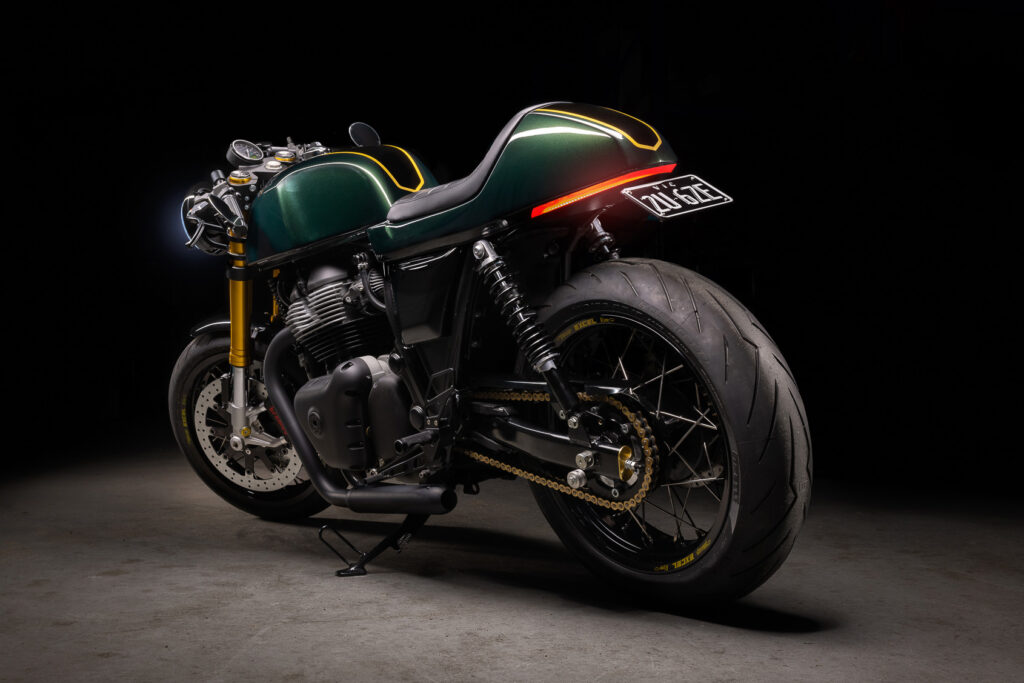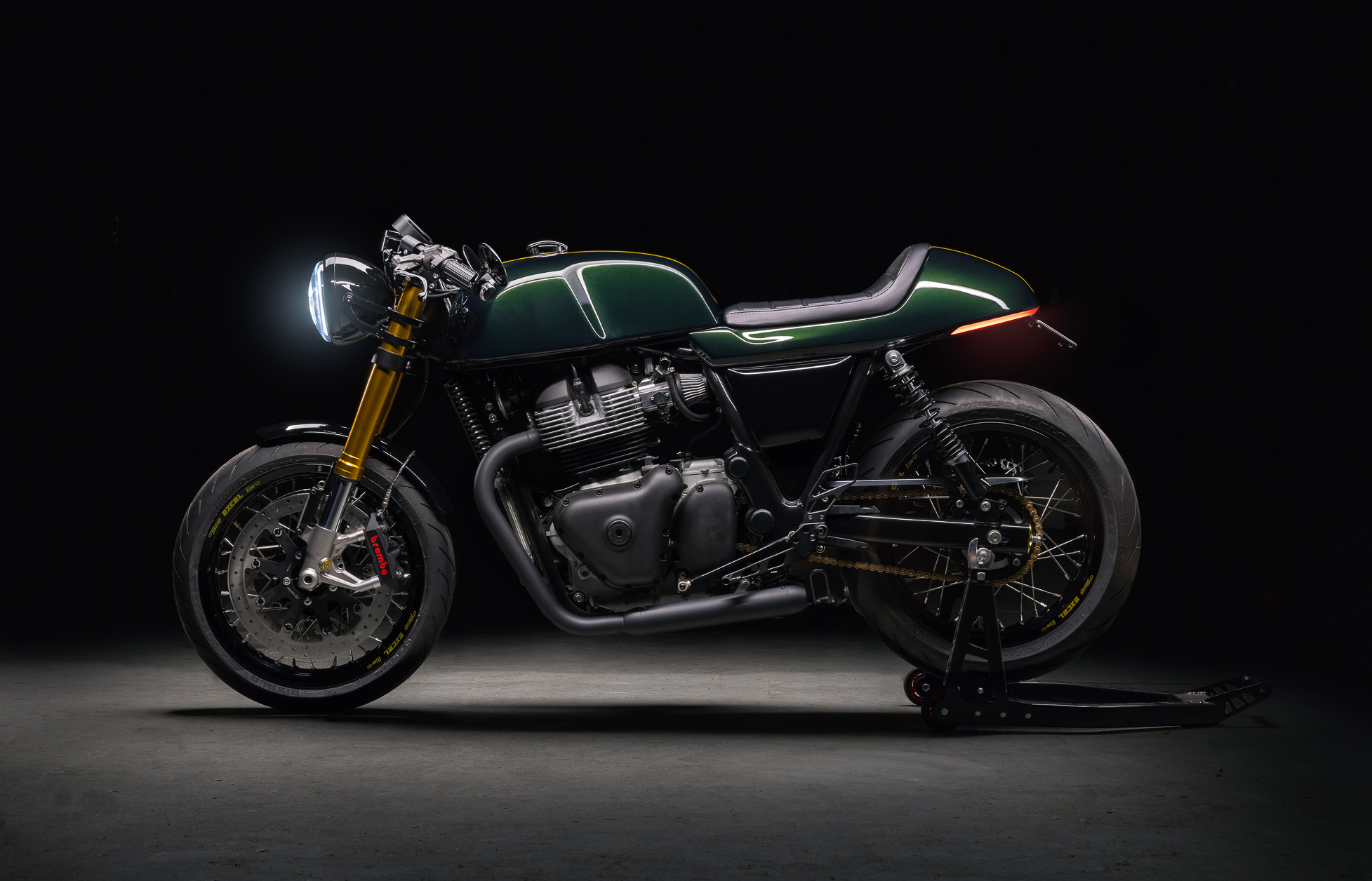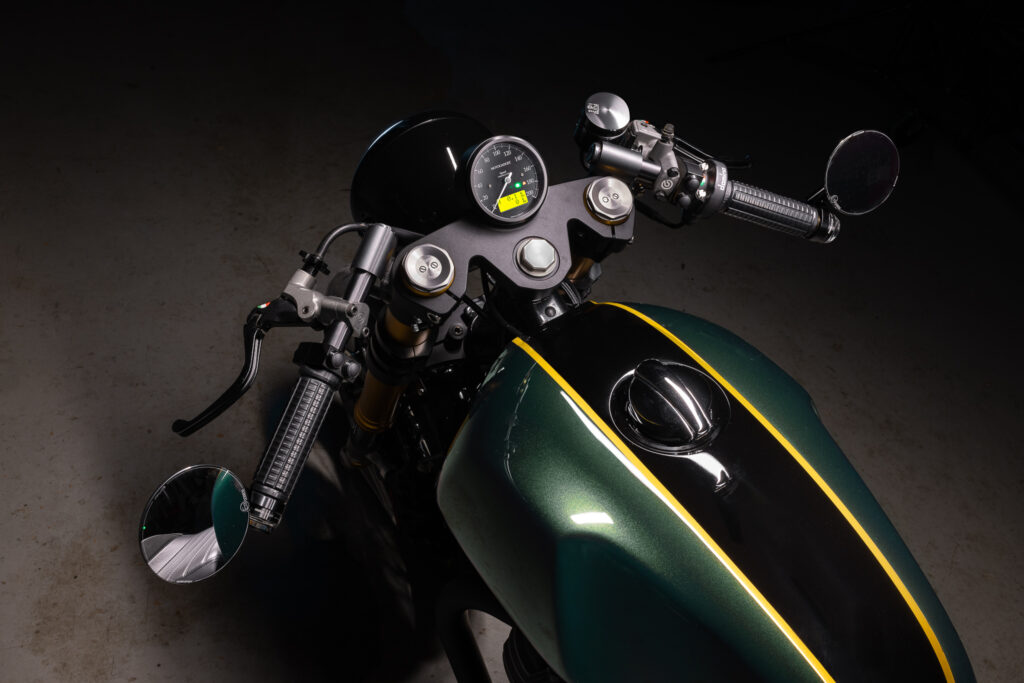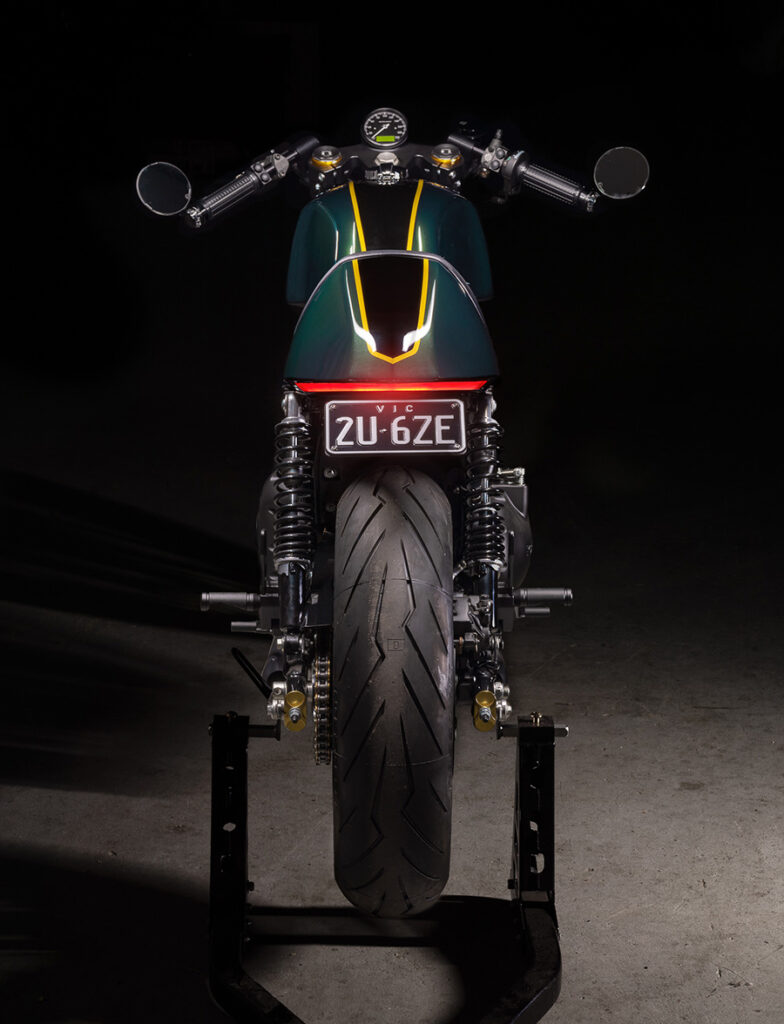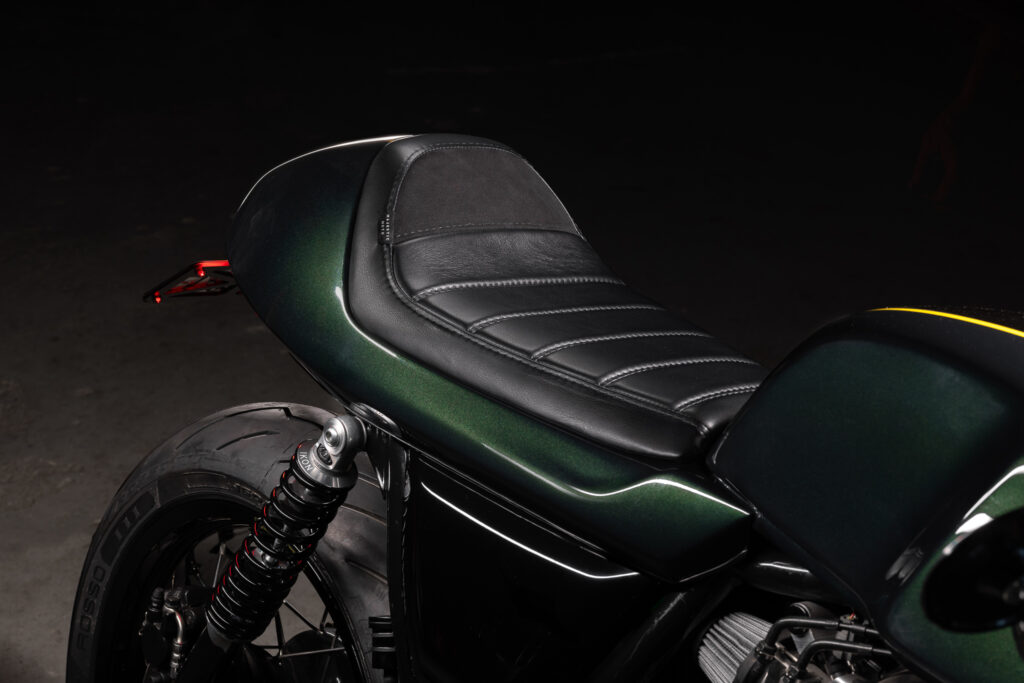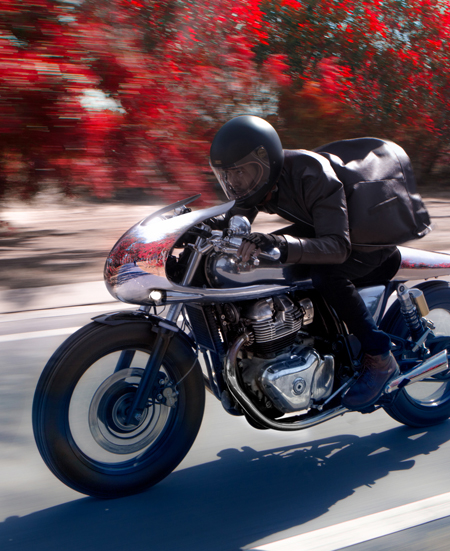The Cerra GT 865 stands out as a unique motorcycle that blends classic inspiration with modern design and engineering. Created by Carl Cerra, this project took a Royal Enfield Continental GT 650 and transformed it into something few would recognize at first glance. By drawing from racing motorcycles of the 1980s and adding a fresh twist, Carl and his team crafted a bike that feels both familiar and entirely new.
From the upgraded engine to the carefully chosen finishing details, the Cerra GT 865 shows what is possible when tradition meets innovation. Each choice in its design and construction reflects a deep understanding of both aesthetics and mechanics, resulting in a motorcycle that pushes the boundaries of what a custom build can achieve.
Key Takeaways
- The Cerra GT 865 brings together vintage racing vibes with new technology.
- Its design, engine, and features set it apart from typical custom motorcycles.
- The project shows how classic bikes can inspire the future of motorcycle design.
Summary of the Cerra GT 865 Project
The Idea Behind This Motorcycle
The Cerra GT 865 project was imagined as something different from the usual style of the Royal Enfield Continental GT. Instead of going for a classic or vintage look, the designer wanted a more modern and unique motorcycle. The goal was to mix the racing bike feel from the 1980s with new technology and design methods.
A main inspiration came from sport bikes, but the builder also used elements found in classic cafe racers. The result is a bike that combines both vintage character and modern strength. The lines, shapes, and finishes give the motorcycle a personality that is hard to find in other builds. The mix of metal and carbon fiber, along with small paint details, ties the whole design together in a balanced way.
| Feature | Approach / Detail |
|---|---|
| Design inspiration | 1980s racing bikes mixed with modern elements |
| Materials used | Carbon fiber panels, metal tank, custom paint |
| Style blend | Hybrid of cafe racer and sport bike features |
| Special touches | Rear-view camera instead of mirrors, clean fairing |
How the Project Began and the Team Involved
This project started with a challenge from ‘Urban Moto,’ the importer of Royal Enfield in Australia. They asked Carl Cerra, the founder of Skunk Machine Design Studio, to create a custom version of the Continental GT 650. Carl used his experience in clay modeling and industrial design to bring a fresh take to the motorcycle.
After sculpting the new parts from clay, Carl worked with Kevin Warwick from Scan Express for 3D scanning. The scanned data was then mirrored to get both sides of the bike matching. Luke Kane from Kaber used this data to make master patterns out of polyethylene, which allowed for precise fiberglass molds. These molds were then used by Jarek at Horsch Carbon to create all the carbon fiber panels.
The engine was upgraded by Charlie Hallam from Hallam Cycle Works, raising it to 865cc and increasing its power. Revelry Cycles provided a performance throttle body to match the new engine setup. Instead of traditional mirrors, a rear-view camera was installed for a cleaner appearance.
Key Collaborators Involved:
- Carl Cerra (Design, vision, clay modeling, project lead)
- Urban Moto (Project initiator, Royal Enfield importer)
- Kevin Warwick (Scan Express) (3D scanning services)
- Luke Kane (Kaber) (Pattern and mold creation)
- Jarek (Horsch Carbon) (Carbon fiber panel production)
- Charlie Hallam (Hallam Cycle Works) (Engine tuning)
- Revelry Cycles (Throttle body supplier)
This teamwork brought together different skills, tools, and ideas to produce a motorcycle that stands out in both design and performance.
Creative Vision and Development
Classic 1980s Motorsports Style
The design took heavy cues from racing bikes of the 1980s, blending a vintage vibe with modern features. The creator avoided classic or stripped-down retro styles, instead choosing a bold, racing-inspired look. Vintage lines mix with modern touches, giving the bike a distinct personality that stands out on the road.
| 1980s Design Features | Modern Elements Added |
|---|---|
| Aggressive fairing | Carbon fiber panels |
| Streamlined bodywork | Discreet rear-view camera |
| Retro seat shape | Updated engine hardware |
Hands-On Clay Shaping
Clay modeling played a big role in perfecting the shape. This method allowed for constant tweaks until each line was just right. Only one side of the bike was sculpted in clay and then 3D scanned, with the other half mirrored digitally for perfect balance. This step made it possible to develop accurate master patterns and detailed mold pieces.
- Steps Used
- Shaped one half with clay
- 3D scanned the finished side
- Mirrored data for symmetry
- Created master patterns for molding
Professional Design Background
Wide experience in industrial design made a difference in this project. The designer had worked with top car brands and developed skill in both automotive and motorcycle design. A deep passion for bikes, which started after getting a motorcycle license at age 35, led to extra attention to detail and a unique final product.
- Experience with major car makers
- Switched focus to motorcycles out of interest
- Emphasized balanced lines and polished details
This careful, expert approach ensured the design was both functional and visually striking.
Custom Design and Engineering
Digital 3D Capture and Mirrored Modeling
First, detailed clay models were crafted by hand to shape the unique body lines. Only one half of the bike’s body was scanned using advanced 3D technology. This digital scan was then mirrored on the computer, making both sides of the motorcycle perfectly symmetrical and saving a lot of time in the process.
- Step 1: Shape with clay by hand
- Step 2: Use 3D scanning for accuracy
- Step 3: Mirror one side digitally for a balanced look
Creating Master Patterns for Production
Next, the digital designs were handed off to create the main forms for building. High-precision polyethylene master pieces were made from the 3D data. These main shapes were then used to produce the fiberglass molds needed for the next phase of production.
| Process Step | Material used | Purpose |
|---|---|---|
| Create master pattern | Polyethylene | Acts as the template for molds |
| Build molds | Fiberglass | Used to shape carbon panels |
Producing Carbon Fiber Bodywork
The final step was making the lightweight body panels. Using the fiberglass molds, expert technicians layered carbon fiber to form the strong and light panels. Most of the body is carbon fiber, while the fuel tank remains metal, creating a balanced and stylish look.
- Only some panels show carbon fiber for visual contrast
- The color choices link the carbon, metal, and painted parts
- Special paint details help keep the bike’s look from being too flashy
Powertrain Improvements
Engine Expansion to 865cc
The original engine was transformed from 650cc to an expanded 865cc. This was achieved by fitting larger pistons and valves, leading to a higher displacement. The upgrade was completed by a specialist with in-depth knowledge of motorcycle engines. This new setup changes the character of the engine, making it stronger and more responsive.
Key changes:
- Larger pistons used
- Bigger valves installed
- Professional engine work
Enhanced Fuel Delivery System
A high-performance throttle body was chosen to supply extra fuel needed by the bigger engine. This upgrade supports the larger displacement and helps ensure the engine runs smoothly at all speeds. The new throttle body improves throttle response and boosts overall efficiency.
Features:
- Better fuel flow for a bigger engine
- Improved engine response
- Supports higher performance
Power Output Boost
With all the changes, the engine now produces 76 horsepower. For comparison, the original engine offered 47 horsepower. This increase was measured after the upgrades were completed.
| Specification | Before | After |
|---|---|---|
| Engine Displacement | 650cc | 865cc |
| Horsepower | 47 hp | 76 hp |
These power gains make a significant difference in performance and riding experience.
Design Materials and Finishing Touches
Fiber Panels and Paint Decisions
The motorcycle uses carbon fiber for most of its panels, giving it a stylish and modern look. These parts are made after scanning the clay models, creating a mirror image for both sides of the bike. Jarek from Horsch Carbon took care of making the carbon pieces.
The fuel tank is not carbon fiber, but made from metal. To make the parts look good together, some sections get a solid color paint. This brings all the pieces together without making the bike look too flashy or overwhelming. The paint choices help the carbon fiber parts stand out.
Materials Used:
| Part | Material | Finish or Color |
|---|---|---|
| Side panels | Carbon fiber | Clear finish |
| Fuel tank | Metal | Painted, solid color |
| Other sections | Carbon fiber | Some with added paint |
Keeping the Look Balanced
There is care taken to avoid using too much carbon fiber everywhere. If every panel had a carbon finish, it could look overdone. Using painted details creates a mix that helps the eye rest and adds to the bike’s clean design.
A rear camera replaces mirrors, letting the bike keep its smooth look. The screen for the camera sits near the speedometer, so nothing sticks out and breaks up the lines of the fairing. This approach keeps the whole design neat and avoids clutter.
Standout Modern Elements
Digital Rear-View System
A compact rear-facing camera was placed at the back of the bike. Instead of standard mirrors, its live video is displayed on a small LCD screen near the speedometer. This makes the area around the handlebars smooth and uncluttered, keeping the bike’s streamlined look.
Key points:
- No traditional mirrors for a cleaner appearance
- Live video feed improves rear visibility
- Screen location: Next to the speedometer, easy to see while riding
Sleek Bodywork and Integrated Style
Clay modeling was used to shape the body, focusing on smooth lines and balanced proportions. Experts scanned one half of the bike to create mirrored digital panels, making the design exact on both sides. Carbon fiber parts were made from these digital molds, giving the bike lightness and a modern finish.
Highlighted design choices:
- Mix of materials: Carbon fiber for panels, sheet metal for the fuel tank
- Color choices: Solid paint details tie different pieces together
- No unnecessary parts: Everything stays tidy, with the camera replacing mirrors
| Material Used | Applied To | Purpose |
|---|---|---|
| Carbon Fiber | Side panels | Reduces weight |
| Sheet Metal | Fuel tank | Keeps classic feel |
| Polyethylene | Master patterns | Forms for carbon fiber |
What Makes This Bike Stand Out
Mixing Classic Café Style with Modern Sport Features
This motorcycle has a style that takes ideas from both old café racers and modern sport bikes. The builder, Carl Cerra, was inspired by racing bikes from the 1980s, but he also gave it new design touches. Instead of making the bike look more basic, he added unique features and details that stand out.
- Engine: The engine is upgraded, making it much more powerful than the original.
- Design: The shape and lines show a mix of retro spirit and current trends.
- Label: It can best be described as a “hybrid café racer” because it blends two types of motorcycles, giving it a personality of its own.
Old-School Looks Meet New Technology
The bike mixes vintage charm with current materials and tech. While parts like the fuel tank keep an old-fashioned look, much of the body is custom-made from carbon fiber, which is light and strong. This gives the bike a sharp, clean appearance without looking overdone.
| Feature | Vintage/Modern Element |
|---|---|
| Fuel tank | Classic, metal |
| Body panels | Modern, carbon fiber |
| Rear view system | High-tech, camera & screen |
Attention to small details, such as paint choices and a hidden rear-view camera, ties the old and new together. This approach creates a bike that stands out by being both familiar and fresh at the same time.
Lasting Impact and What’s Next for the Cerra GT 865
Small Batch Creation
Only a few Cerra GT 865 motorcycles have been produced. After the original custom build, there are plans to craft 24 more. Each bike is carefully assembled, making every unit stand out.
Key Details:
- Hand-built in limited numbers
- Unique design for every bike
- Special attention to materials and quality
This makes the Cerra GT 865 rare and highly sought after by collectors.
Shaping New Sport Bike Styles
The Cerra GT 865 brings together classic ideas and new trends. Its lines echo racing bikes from the 1980s but updated with modern features and carbon fiber parts.
How It Influences Sport Bikes:
- Uses vintage-inspired looks with modern performance
- Blends clean, simple shapes with up-to-date tech, like a rear-view camera
- Inspires others to mix tradition and innovation
Many hope that future sport bikes will learn from the Cerra GT 865—by showing that style, function, and heritage can fit together in new ways.
Final Thoughts
Cerra GT 865 stands out for several reasons:
- Unique blend of 1980s racing inspiration with a modern edge
- Impressive craftsmanship, especially in clay modeling and carbon fiber work
- Careful coordination between specialists at each step
- Smart technical upgrades, like a powerful 865cc engine and custom throttle bodies
- Innovative solutions such as a rear view camera instead of traditional mirrors
| Feature | Details |
|---|---|
| Engine | Upgraded from 650cc to 865cc, now at 76 horsepower |
| Main Material | Carbon fiber panels, sheet metal fuel tank |
| Design Method | Clay modeling, 3D scanning, digital mirroring |
| Modern Touches | Rear view camera with discreet LCD display |
| Number of Units | 24 additional units planned |
This project highlights what is possible when careful design meets creative engineering. The Cerra GT 865 shows how vintage lines and new technology can work together to make something truly memorable.
